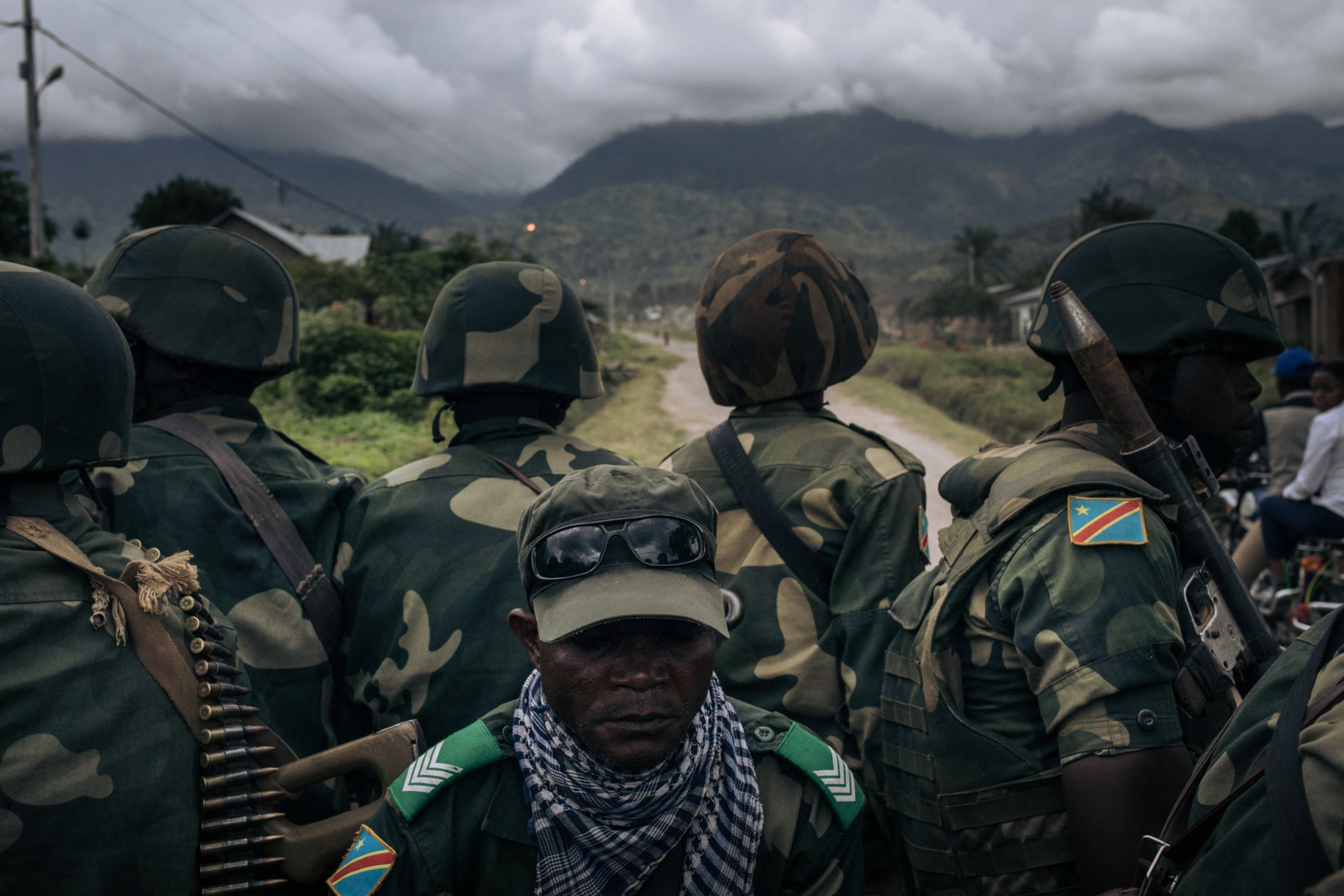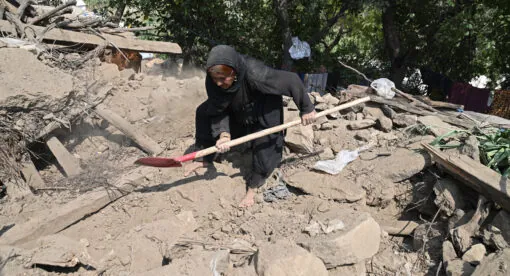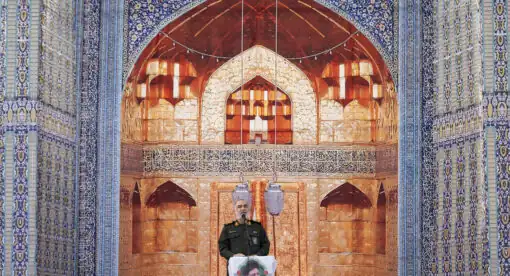The Allied Democratic Forces, a militant group in the Democratic Republic of Congo, has become part of the Islamic State, and Uganda has sent troops into Congo after a series of bombings in Kampala. The ADF’s local-transnational hybrid nature, and the shifts in capacity they have brought, complicate efforts to effectively confront the group.
In April 2019, Islamic State propaganda channels began issuing claims of attacks by the Allied Democratic Forces (ADF), a long-standing Islamist rebel group operating in eastern Democratic Republic of Congo. Taking many by surprise, the seeming integration of the ADF into the Islamic State’s network of affiliated local insurgencies as a branch of its “Central Africa Province” has generated sustained debate over the veracity, nature, and policy implications of the relationship between the ADF and the Islamic State. As the ADF continues to expand its areas of operation in Congo, displace tens of thousands, attract recruits from across the region, and use its Congolese holdings to stage attacks abroad, understanding these ties and their implications is a critical foundation for understanding the ADF’s trajectory, its impact on Congo and the region, and appropriate policy responses.
The emergence of the Islamic State’s “Central Africa Province” has been met with skepticism by some analysts of Congo’s myriad internal conflicts, which have simmered and raged since the “end” of the Second Congo War in 2003. Analysts have questioned the depth of ties between the Islamic State’s central leadership and its ostensible local affiliate, have critiqued an emphasis on those ties given the limited command and control of the ADF by the Islamic State’s central leadership, and have argued that framing the ADF as an Islamic State affiliate essentializes a group born more of local and regional circumstances than the global Salafist-jihadist movement. The U.N. Group of Experts on eastern Congo concluded in June 2020 that it could find no substantial links between the ADF and the Islamic State, though subsequent reports have documented extensive evidence of ties while stating that no conclusive evidence of the Islamic State’s direct command and control over the ADF’s day-to-day operations could be found.
Some of these critiques have merit, and the recent deployment of thousands of Ugandan troops into Congo to fight the ADF alongside the Congolese military is unlikely to inspire confidence among those arguing that an overemphasis on transnational affiliation risks encouraging the kinds of counterproductive counterterrorism templates adopted elsewhere. But just as overemphasizing a group’s adopted transnational identity risks policies poorly suited for local circumstances, failure to recognize important shifts in a group’s self-conception, its behavior, and the resources available to it risks misjudging its trajectory and capabilities. Further, critiques that border on outright denial of transnational affiliation risk misjudging crucial determinants of the ADF’s rapid escalation and expansion since 2017, only making it more likely that policymakers fail to adequately protect the affected communities that they must prioritize.
ADF Becomes Part of the Islamic State
More than two years after the Islamic State’s propaganda apparatus issued the first claims of ADF attacks, the existence of sustained, durable, and substantial links between the ADF and the Islamic State are incontestable.
Originating in intra-Muslim clerical disputes of the early 1990s, the ADF began after its longtime leader Jamil Mukulu was released from prison following a violent attempt to take over the leadership of Uganda’s government-recognized Muslim clerical authority. Quickly routed by Ugandan security forces in early 1995, Mukulu’s radical splinter fled to eastern Congo, allied with another Ugandan rebel movement, and found sponsorship from the regime of longstanding Congolese dictator Mobutu Sese Seko. Mobutu sought a proxy with which to counter Kampala before and during the cataclysmic wars that began in October 1996 and resulted in Mobutu’s ouster.
While severely degraded by 2000, the ADF under Mukulu managed to carve out a niche in Congo’s post-war power vacuum, establishing itself as one of dozens of Congolese and foreign militant groups. Though the ADF’s relationships with surrounding Congolese communities had been relatively amicable during the 2000s, Congolese military (FARDC) offensives beginning in 2010 led the ADF to begin targeting those communities, culminating in a 2014 Congolese operation that resulted in an ADF “on the brink of extermination” and Mukulu fleeing the country before being arrested in Tanzania a year later. What remained of the ADF subsequently came under the command of Mukulu’s deputy, Musa Baluku.
Attempting to rebuild the group and bolster his own legitimacy, Baluku pivoted the ADF away from Mukulu’s more strictly Ugandan focus. While certainly Islamist, Mukulu’s political program at least nominally dreamt of overthrowing the regime of Ugandan President Yoweri Museveni and replacing it with an Islamic government. As Baluku attempted to rebuild the organization – amid a campaign of massacres in which the ADF was one of multiple perpetrators – Baluku opted to bolster his legitimacy as the ADF’s new leader and cultivate new streams of support through the adoption of the kind of transnational Salafist-jihadist identity espoused by groups like al Qaeda and the Islamic State.
This became evident in 2016 following the arrival of Meddie Nkalubo, a young Ugandan man who joined the ADF in early 2016. Empowered by Baluku to manage the ADF’s fledgling social media operation, Nkalubo began producing propaganda videos that overtly mirrored the style of the Islamic State. In 2016 or 2017, Baluku broke with Mukulu, who was sending commands from prison to refuse any overtures from the Islamic State, arguing that instead of Mukulu’s focus on Uganda, the ADF should attempt to create an Islamic state in Congo.
By early 2017, contact had been made with Islamic State financiers in Kenya, and the ADF received transfers of money throughout 2017. In October 2017, a video circulated on unofficial Islamic State supporters’ channels of a Tanzanian man of Arab descent exhorting others to come to “Dar al Islam of the Islamic State in Central Africa,” the first public mention of “Islamic State” and “Central Africa” as a name for the group and a clear aspirational reference to the Islamic State. While the primary Islamic State financier sending money to the ADF was arrested in July 2018, then-leader Abu Bakr al-Baghdadi himself – while listing wilaya (provinces) that had joined the Caliphate – mentioned “Central Africa” alongside Yemen, Sinai, West Africa (Boko Haram) and others in an August 2018 speech, a reference little noticed at the time.
“Dual track” media releases by the Islamic State’s propaganda apparatus and the ADF’s own in-house media arm have clearly demonstrated the group’s enthusiasm for its membership in the Islamic State’s network of affiliated provinces. An ex-combatant told the U.N. Group of Experts that Baluku had pledged allegiance to al-Baghdadi in an internally distributed video as early as June 2018, while subsequent internal and public releases have repeated these claims. In the ADF’s submission to the summer 2019 Islamic State “And the Best Outcome is for the Righteous” video series, in which affiliates from the around the world publicly renewed their oaths to al-Baghdadi in the wake of Baghuz, Baluku explicitly declared, “We are reaffirming our Oaths of Allegiance to our Islamic Caliphate Sheikh al Mujahid Abu Bakr al Husseini al Qurash.”

In videos released in 2019 and 2020 through the ADF’s own media channels, senior leaders repeatedly referenced al-Baghdadi as the group’s leader, offered reassurances to members following his death in October 2019, and defended the Islamic State’s decision to declare its caliphate despite the military pressure against the group. In September 2020, Baluku went so far as to explicitly state that “ADF was merely an alliance out of necessity for a certain time and … we are … the Central Africa Province which is one province among the numerous provinces that make up the Islamic State that is under the Caliph and Leader of all Muslims … [Baghdadi’s successor] Abu Ibrahim al-Hashimi al-Quraishi.”
When Islamic State began releasing claims and media of ADF attacks in April 2019, it became clear that communications had become sustained and consistent. It was almost certainly no coincidence that the Islamic State began claiming the ADF’s attacks less than a month after the fall of Baghuz, the last stretch of its “territorial caliphate” in Iraq and Syria to fall to the U.S.-backed Syrian Democratic Forces. While Baluku saw recognition as a means of securing his position as leader, the Islamic State saw the ADF as another front into which it could expand its reach, even if this “expansion” was really the adoption of a local insurgency rather than substantial movement of personnel or weaponry.
The ADF offered the Islamic State the opportunity to reassert itself as the world’s pre-eminent jihadist movement, while Islamic State offered the ADF the opportunity to boost its own reputation as part of that movement and secure the critical financial support that enabled Baluku to rebuild the ADF.
Failed Attempts to Defeat the ADF
While it remains difficult to ascertain the degree and impact of material benefits the Islamic State provided to the ADF, under Baluku the ADF has repeatedly demonstrated its resiliency and capacity for violence, and Congolese civilians have paid the heaviest price. Since Baluku’s rise to power, the ADF has carried out a systematic campaign of massacres and abuses that have killed thousands. Raiding isolated rural villages, assaulting fortified FARDC positions, and overrunning larger towns on main transportation arteries, the ADF has not only demonstrated the inability of the FARDC and the U.N.’s largest peacekeeping mission to protect the population, but also has repeatedly inflicted serious losses on its military opponents. Despite repeated FARDC offensives, and the FARDC’s announcement that more than 2,000 soldiers had been killed in fighting in Beni since October 2014, the ADF’s area of operations has seen a 364% increase.

Congolese President Felix Tshisekedi devoted significant political capital in his promises to defeat the ADF and end its massacres in Beni, and despite his inability to secure the foreign support he petitioned for during the spring and summer of 2019, it was politically untenable to fail to follow through due to a lack of international assistance. The Congolese military thus launched a major operation against the group in late October 2019, just weeks after Baghdadi’s death in northwestern Syria. The operation was initially successful, but the ADF responded with a vicious campaign of massacres as it sought to divert the FARDC toward defending civilians and to punish and displace civilians from the areas it entered as it withdrew from the FARDC’s advances. In the three months after the offensive began, the ADF killed at least 334 civilians, according to data from the Kivu Security Tracker (KST), a conflict monitoring project covering eastern Congo. Local human rights groups placed the figure even higher.
After a brief decline in early 2020, the number and death toll of attacks has steadily risen, averaging 84 civilian deaths per month from May 2020 to September 2021, compared to an average of 22 civilian deaths per month during the 12 months preceding the offensive, according to KST data. Huge numbers of FARDC troops remain deployed to hundreds of bases across Beni territory. Despite the October 2019 offensive, and later the declaration of martial law in April 2021, the ADF has grown increasingly active, launching more and deadlier attacks on civilian and military targets. It has staged complex assaults on important targets outside its typical areas of operation, perhaps most notably a prison break that freed 1,333 detainees, including 236 jailed ADF combatants. More recently, the ADF has pushed into areas near Komanda in Ituri – the furthest north that the ADF has ever operated.

Also notable has been a series of urban terrorist bombings, a significant escalation in the ADF’s operational reach since their relationship with Islamic State began in 2017. These attacks have included three bombings in Beni city in June, a disrupted plot to stage a suicide bombing at a state funeral in northern Uganda, and bombings of a police station and a restaurant in Kampala in October, the latter two of which were claimed by the Islamic State – its first claims of attacks in Uganda.
In addition, Rwanda announced the August arrests of several ADF cells plotting attacks in Kigali, where the ADF has never before operated but from which Islamic State has previously recruited. Islamic State supporters have previously threatened Rwanda over its intervention in northern Mozambique, suggesting the potential for the ADF’s burgeoning regional capacity to be used to create pressure on behalf of other Islamic State affiliates. Most recently, Islamic State claimed responsibility on behalf of the ADF for a triple suicide bombing in Kampala on Nov. 16, by far the most complex, powerful and deadly attack during the ADF’s latest campaign outside of Congo.
This is a scale of violence in both intensity and geographic scope that has not been seen from the ADF since the 1990s, if ever, and the group’s ability to maintain this tempo over such a wide area suggests a long-term improvement in its military capacity and ability to coordinate disparate units in Beni, Ituri, and beyond. More than seven years after Beni’s massacres began, the Congolese military’s current strategy has been unable to stem the ADF’s ability to carry out atrocities, and emerging joint operations between FARDC and UPDF would be wise to learn from those past failures.
Constraints on Policy Responses
This tempo of activity and the failure of repeated offensive operations to defeat the ADF has understandably generated calls for non-military approaches to stemming the ADF’s atrocities. While some civil society actors have called for negotiations – born of understandable frustration at the inability of securitized approaches to ameliorate the violence – the possibility of negotiating a reduction in violence should be approached with duly limited expectations. Previous ADF demands for “negotiations” have been limited to threats delivered by released hostages, while previous engagements with authorities have been limited to corrupt deals with Congolese military officers to continue violence. Whatever possibilities of a negotiated solution might have existed are now complicated by the ADF’s membership in a global movement whose entire existence is predicated on the illegitimacy of every possible negotiating partner.

Further complicating attempts to limit the group’s capacity to recruit and sustain itself is that the ADF’s relationship with local civilian populations is structurally distinct from the relationships that other jihadist insurgencies in Africa have with civilians in their areas of operation. According to ex-combatants and former abductees cited by the U.N. Group of Experts, Ugandans continue to comprise the single largest contingent within the ADF, particularly within the leadership. While Congolese form the second largest group, most Congolese combatants are forcibly recruited after abduction or false promises of employment.
Unlike other jihadist groups in Africa, the ADF does not try to appeal to local civilian populations by providing social services and has not attempted to portray itself to local civilians as a preferable alternative to the Congolese state. What local engagement has occurred has historically been limited to reported tactical deals with other Congolese militia groups, extortion of local farmers, or economic cooperation with local figures. Perhaps most importantly, the Muslim community in the areas where the ADF operates remains a tiny fraction of the total population, while the ADF’s leadership utilizes extremist rhetoric to justify indiscriminate attacks against the largely-Christian local population.
While recent developments have suggested that the ADF has attempted to make inroads with the Kinyarwanda-speaking Banyabwisha community in southern Ituri, capitalizing on intercommunal conflict between the Banyabwisha and other local groups, the core of the ADF remains largely detached from local communities in ways that other jihadist insurgencies on the continent are not. This relative detachment thus also poses a challenge to alternative, non-securitized responses. Improving governance and social service delivery in Beni’s towns would have little impact on an ADF whose leadership is almost entirely foreign, whose recruits are in large part drawn from foreign Salafist networks, and whose strategy seems to not be built around forming an alternative to the Congolese state but rather to carve out a fiefdom cleared of both military opponents and civilians.
Amid the Ugandan military’s entry into eastern Congo, policymakers will find it challenging and difficult to implement comprehensive approaches. Military offensives have repeatedly failed, and barring a decisive victory for which past experiences offer limited confidence, it is extremely unlikely that yet another “final offensive” would result in a different outcome. Simultaneously, non-militarized attempts to resolve underlying community grievances may have peripheral impacts on the potential for opportunistic alliances between the ADF and other Congolese militias, but will have limited impact on the ADF itself. Lastly, attempts to stem flows of foreign fighters will likely prove difficult given the breadth of locations from which the ADF recruits. This is certainly no hopeful picture, but successfully confronting a group that has repeatedly proven its resiliency like the ADF will require recognition of these limitations and the effective adaptation of both military and non-military strategies to compensate for the unique challenges posed by the group.
Neither Local nor Transnational, but Both
The ADF represents a confluence of unique attributes and common characteristics, simultaneously defined by its particular environment and shaped by its transnational aspirations. It would be folly to fail to recognize the importance of an adopted transnational identity and the impacts this identity has upon the ADF’s ambitions, resources, and ability to sustain itself, just as it would be folly to ignore its particularities in order to approach it with the same securitized responses that have failed to dent both the activities of the ADF and those of other jihadist groups across the continent. Policymakers must instead recognize the limitations placed on counterterrorism strategy, demobilization efforts and countering foreign recruitment by the ADF’s unique evolution, particular circumstances and persistent adaptability.
The Allied Democratic Forces are now enthusiastically “Dawlat al-Islam in Central Africa.” Analysts and policymakers must understand the salience of this evolution while respecting the unique characteristics and local circumstances that have enabled its leaders to wage war in exile for a quarter century. The ADF’s unwillingness to be neatly categorized as solely a local rebel group or transnational terrorist affiliate have bedeviled attempts to contain its violence, and failure to understand this confluence of characteristics will doom future attempts to the same failures. With the Ugandan military announcing air strikes and quickly claiming successes against the ADF, parsing these nuances will be all the more critical in ensuring that this latest “final offensive” does not result in the same failures as its predecessors.
Ryan O’Farrell is a Senior Analyst at the Bridgeway Foundation and a co-author of “The Islamic State in Africa: The Emergence, Evolution, and Future of the Next Jihadist Battlefront.” You can follow him on Twitter at @ryanmofarrell.






